现在分词作状语有几种形式-有用
- 格式:pptx
- 大小:350.17 KB
- 文档页数:32
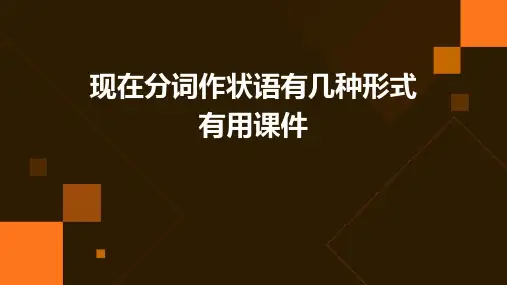
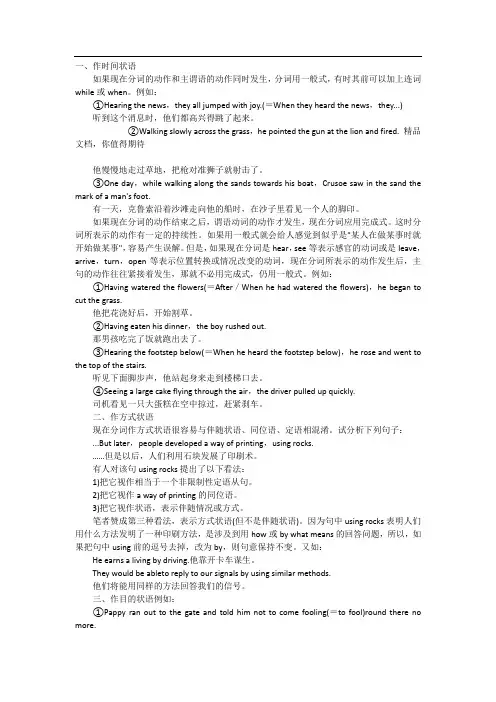
一、作时间状语如果现在分词的动作和主谓语的动作同时发生,分词用一般式,有时其前可以加上连词while或when。
例如:①Hearing the news,they all jumped with joy.(=When they heard the news,they...)听到这个消息时,他们都高兴得跳了起来。
②Walking slowly across the grass,he pointed the gun at the lion and fired. 精品文档,你值得期待他慢慢地走过草地,把枪对准狮子就射击了。
③One day,while walking along the sands towards his boat,Crusoe saw in the sand the mark of a man's foot.有一天,克鲁索沿着沙滩走向他的船时,在沙子里看见一个人的脚印。
如果现在分词的动作结束之后,谓语动词的动作才发生,现在分词应用完成式。
这时分词所表示的动作有一定的持续性。
如果用一般式就会给人感觉到似乎是"某人在做某事时就开始做某事",容易产生误解。
但是,如果现在分词是hear,see等表示感官的动词或是leave,arrive,turn,open等表示位置转换或情况改变的动词,现在分词所表示的动作发生后,主句的动作往往紧接着发生,那就不必用完成式,仍用一般式。
例如:①Having watered the flowers(=After/When he had watered the flowers),he began to cut the grass.他把花浇好后,开始割草。
②Having eaten his dinner,the boy rushed out.那男孩吃完了饭就跑出去了。
③Hearing the footstep below(=When he heard the footstep below),he rose and went to the top of the stairs.听见下面脚步声,他站起身来走到楼梯口去。
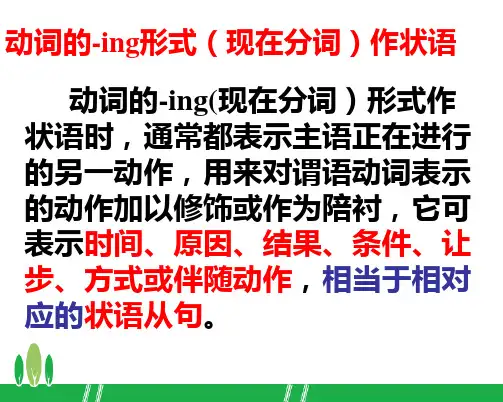
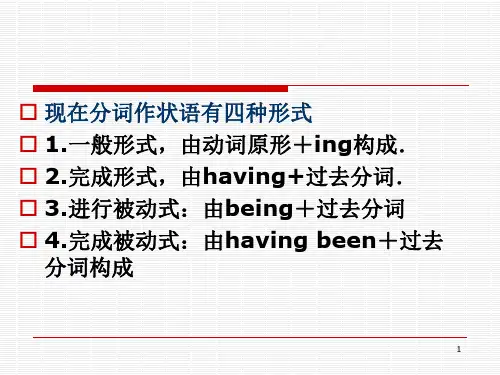


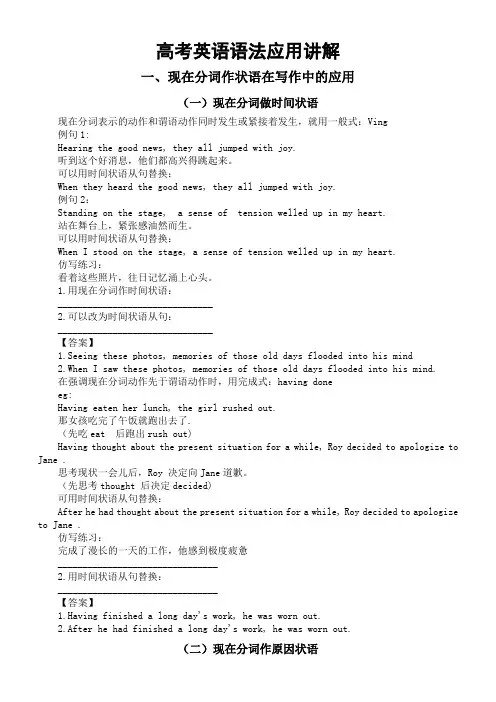
高考英语语法应用讲解一、现在分词作状语在写作中的应用(一)现在分词做时间状语现在分词表示的动作和谓语动作同时发生或紧接着发生,就用一般式:Ving例句1:Hearing the good news, they all jumped with joy.听到这个好消息,他们都高兴得跳起来。
可以用时间状语从句替换:When they heard the good news, they all jumped with joy.例句2:Standing on the stage, a sense of tension welled up in my heart.站在舞台上,紧张感油然而生。
可以用时间状语从句替换:When I stood on the stage, a sense of tension welled up in my heart.仿写练习:看着这些照片,往日记忆涌上心头。
1.用现在分词作时间状语:_______________________________2.可以改为时间状语从句:_______________________________【答案】1.Seeing these photos, memories of those old days flooded into his mind2.When I saw these photos, memories of those old days flooded into his mind.在强调现在分词动作先于谓语动作时,用完成式:having doneeg:Having eaten her lunch, the girl rushed out.那女孩吃完了午饭就跑出去了.(先吃eat 后跑出rush out)Having thought about the present situation for a while, Roy decided to apologize to Jane .思考现状一会儿后,Roy 决定向Jane道歉。
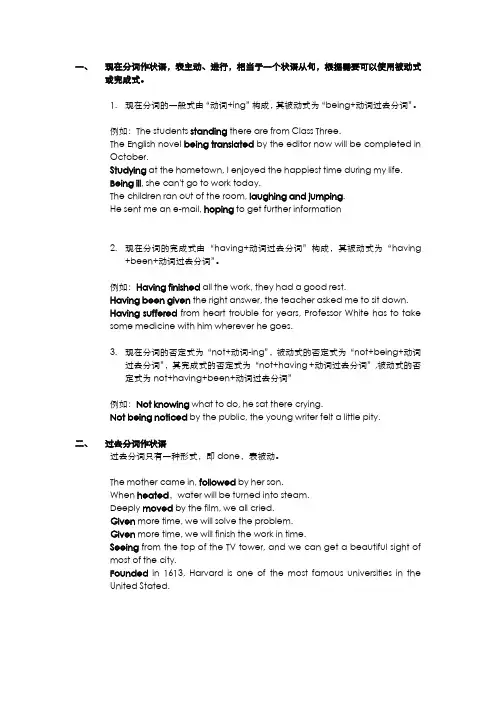
一、现在分词作状语,表主动、进行,相当于一个状语从句,根据需要可以使用被动式或完成式。
1.现在分词的一般式由“动词+ing”构成,其被动式为“being+动词过去分词”。
例如:The students standing there are from Class Three.The English novel being translated by the editor now will be completed inOctober.Studying at the hometown, I enjoyed the happiest time during my life.Being ill, she can't go to work today.The children ran out of the room, laughing and jumping.He sent me an e-mail, hoping to get further information2.现在分词的完成式由“having+动词过去分词”构成,其被动式为“having+been+动词过去分词”。
例如:Having finished all the work, they had a good rest.Having been given the right answer, the teacher asked me to sit down.Having suffered from heart trouble for years, Professor White has to takesome medicine with him wherever he goes.3.现在分词的否定式为“not+动词-ing”,被动式的否定式为“not+being+动词过去分词”,其完成式的否定式为“not+having +动词过去分词”,被动式的否定式为not+having+been+动词过去分词”例如:Not knowing what to do, he sat there crying.Not being noticed by the public, the young writer felt a little pity.二、过去分词作状语过去分词只有一种形式,即done,表被动。
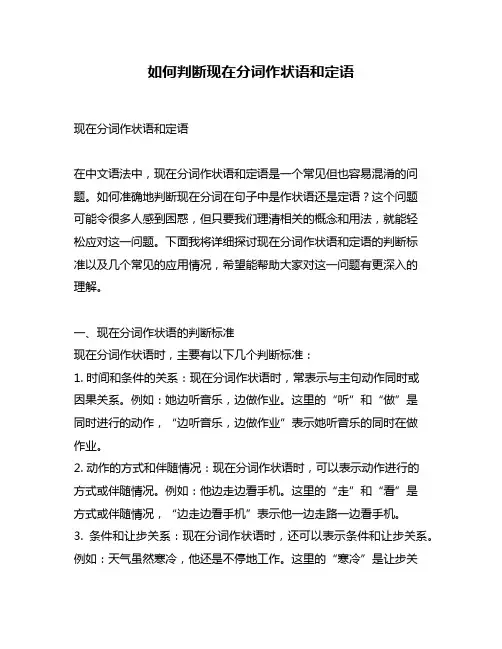
如何判断现在分词作状语和定语现在分词作状语和定语在中文语法中,现在分词作状语和定语是一个常见但也容易混淆的问题。
如何准确地判断现在分词在句子中是作状语还是定语?这个问题可能令很多人感到困惑,但只要我们理清相关的概念和用法,就能轻松应对这一问题。
下面我将详细探讨现在分词作状语和定语的判断标准以及几个常见的应用情况,希望能帮助大家对这一问题有更深入的理解。
一、现在分词作状语的判断标准现在分词作状语时,主要有以下几个判断标准:1. 时间和条件的关系:现在分词作状语时,常表示与主句动作同时或因果关系。
例如:她边听音乐,边做作业。
这里的“听”和“做”是同时进行的动作,“边听音乐,边做作业”表示她听音乐的同时在做作业。
2. 动作的方式和伴随情况:现在分词作状语时,可以表示动作进行的方式或伴随情况。
例如:他边走边看手机。
这里的“走”和“看”是方式或伴随情况,“边走边看手机”表示他一边走路一边看手机。
3. 条件和让步关系:现在分词作状语时,还可以表示条件和让步关系。
例如:天气虽然寒冷,他还是不停地工作。
这里的“寒冷”是让步关系,“天气虽然寒冷”表示尽管天气寒冷,他还是不停地工作。
二、现在分词作定语的判断标准现在分词作定语时,主要有以下几个判断标准:1. 逻辑主语的确定:现在分词作定语时,需要确定它所修饰的名词或代词,即逻辑主语。
例如:她穿着一身红色的连衣裙。
这里的“红色的连衣裙”中的“红色的”就是现在分词作定语修饰的名词“连衣裙”,即“红色的”说明了“连衣裙”的颜色。
2. 定语的限定性:现在分词作定语时,通常用于限定被修饰名词的范围或描述名词特征。
例如:一群欢笑的孩子。
这里的“欢笑的”说明了孩子的状态或特征。
3. 定语与被修饰词的关系:现在分词作定语时,需要注意它和被修饰词的逻辑关系,通常是名词的属性或特征。
例如:周围响起了嬉笑声。
这里的“嬉笑”是现在分词作定语修饰名词“声”,表示了声音的特征。
我们可以通过以上几个判断标准来准确地判断现在分词是作状语还是定语。
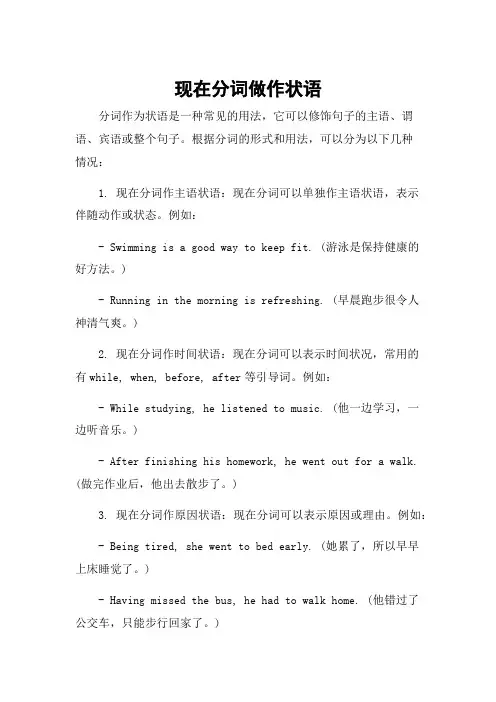
现在分词做作状语分词作为状语是一种常见的用法,它可以修饰句子的主语、谓语、宾语或整个句子。
根据分词的形式和用法,可以分为以下几种情况:1. 现在分词作主语状语:现在分词可以单独作主语状语,表示伴随动作或状态。
例如:- Swimming is a good way to keep fit. (游泳是保持健康的好方法。
)- Running in the morning is refreshing. (早晨跑步很令人神清气爽。
)2. 现在分词作时间状语:现在分词可以表示时间状况,常用的有while, when, before, after等引导词。
例如:- While studying, he listened to music. (他一边学习,一边听音乐。
)- After finishing his homework, he went out for a walk. (做完作业后,他出去散步了。
)3. 现在分词作原因状语:现在分词可以表示原因或理由。
例如:- Being tired, she went to bed early. (她累了,所以早早上床睡觉了。
)- Having missed the bus, he had to walk home. (他错过了公交车,只能步行回家了。
)4. 现在分词作结果状语:现在分词可以表示结果,常用的情况有so, therefore等引导词。
例如:- He studied hard so as to pass the exam. (他努力学习,以便通过考试。
)- The weather was bad, so they stayed at home. (天气不好,所以他们呆在家里。
)。
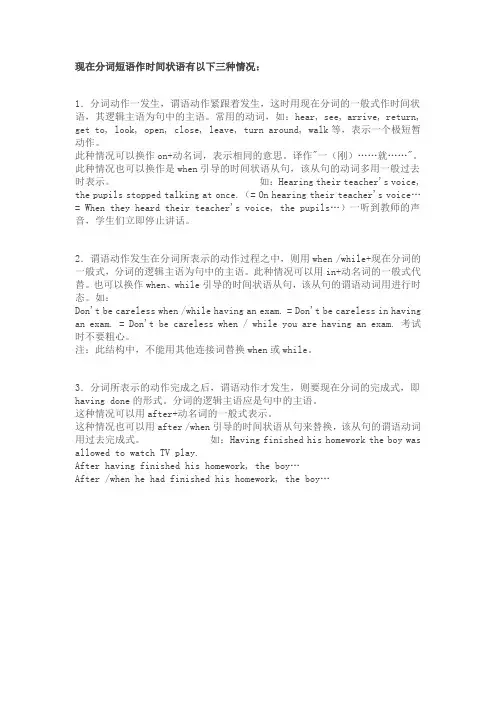
现在分词短语作时间状语有以下三种情况:1.分词动作一发生,谓语动作紧跟着发生,这时用现在分词的一般式作时间状语,其逻辑主语为句中的主语。
常用的动词,如:hear, see, arrive, return, get to, look, open, close, leave, turn around, walk等,表示一个极短暂动作。
此种情况可以换作on+动名词,表示相同的意思。
译作"一(刚)……就……"。
此种情况也可以换作是when引导的时间状语从句,该从句的动词多用一般过去时表示。
如:Hearing their teacher's voice, the pupils stopped talking at once.(= On hearing their teacher's voice… = When they heard their teacher's voice, the pupils…)一听到教师的声音,学生们立即停止讲话。
2.谓语动作发生在分词所表示的动作过程之中,则用when /while+现在分词的一般式,分词的逻辑主语为句中的主语。
此种情况可以用in+动名词的一般式代替。
也可以换作when、while引导的时间状语从句,该从句的谓语动词用进行时态。
如:Don't be careless when /while having an exam. = Don't be careless in having an exam. = Don't be careless when / while you are having an exam. 考试时不要粗心。
注:此结构中,不能用其他连接词替换when或while。
3.分词所表示的动作完成之后,谓语动作才发生,则要现在分词的完成式,即having done的形式。
分词的逻辑主语应是句中的主语。
动名词和现在分词做状语动名词和现在分词作状语都是动词的一种非谓语形式,属于动词性状语,可以用来表示主句中动作的伴随情况,或者指出主句中动作发生的时间、原因、方式等,有时也可以体现主句中动作的效果。
一、动名词作状语动名词作状语是指用动名词来表示主句中的动作,它包括“-ing形式”和“to do形式”。
1. -ing形式动名词的-ing形式是指使用动词的现在分词形式,它可以用来表示主句所述的动作的伴随情况,它可以用来修饰动词,也可以用来修饰名词、形容词或副词,甚至可以单独作状语。
e.g. I found him walking in the street.他我发现他在街上走。
2. to do形式动名词的to do形式是指使用不定式形式,它一般表示主句中动作的目的或意图,它可以用来修饰动词,也可以用来修饰名词、形容词或副词,甚至可以单独作状语。
e.g. He left early to catch the train.他早早离开是为了赶火车。
二、现在分词作状语现在分词也可以作状语,它表示主句中的动作发生的时间、原因、方式等,有时也可以体现主句中动作的效果。
1. 表示时间现在分词常用来表示一个动作发生的时间,可以用来修饰动词,也可以用来修饰名词、形容词或副词,甚至可以单独作状语。
e.g. Arriving late, he found his seat occupied.他迟到了,发现自己的座位被占了。
2. 表示原因现在分词常用来表示一个动作发生的原因,它一般作为状语放在主句的前面。
e.g. Being sick, he stayed home.他因为生病,所以留在家中。
3. 表示方式现在分词常用来表示一个动作的方式,它一般作为状语放在主句的前面。
e.g. Taking a taxi, we got there in no time.我们坐出租车很快就到了。
4. 表示效果现在分词常用来表示一个动作的效果,它一般作为状语放在主句的前面。
现在分词在句子中作状语的用法介绍现在分词在句子中作状语的用法介绍你知道现在分词在句子中的用法吗?下面是小编收集的现在分词在句子中作状语的用法介绍。
欢迎阅读!一、分词在句子中作状语,可以表示时间、条件、原因、结果、让步、伴随等。
分词(短语)作状语时,其逻辑主语应与句中主语相一致。
当现在分词表示的动作发生在谓语动词之前时, 则用现在分词的完成式;当所表示的`动作与谓语的动作同时发生, 则用现在分词的一般式。
完成或被动关系用过去分词。
二、现在分词作状语时,其逻辑主语应该与句子的主语一致,但有时现在分词的主语与其所在句中的主语并不一致,这种现在分词即所谓的垂悬现在分词。
垂悬现在分词容易使句意模糊,甚至造成歧义,因而通常被认为是不合规范或错误的用法。
1.Searching along the deck,it had taken him some time to find a doctor.他沿着甲板找了好久才找到一名医生。
(searching的逻辑主语是句中的him)2.Walking or sleeping,this subject was always in my mind.不论是走路或睡觉,我总是在想着这个问题。
(walking or sleeping的逻辑主语是句中的my)3.Traveling is interesting but tiring.旅行是有趣的,但是使人疲劳4.The pupils will get confused if they are made to learn too much.如果让学生学得太多,他们会感到糊涂的。
5.The argument is very convincing.他的论点很令人信服。
6.They were very excited at the news.听到这个消息,他们非常激动。
三、现在分词或过去分词作状语时,有时可以在分词前加while,when, once, although, until, if等连词。
英语动词作状语的结构及其用法状语是英语中常用的一种修饰成分,用于修饰动词、形容词、副词或句子。
其中,动词作状语的结构和用法是研究者需要掌握的重点之一。
1. 动词作状语的结构在英语中,动词可以作为状语使用的结构主要包括以下几种形式:1. 动词的带宾语不定式形式作状语:- 例如:I went to the supermarket to buy some groceries.2. 动词的动名词形式作状语:- 例如:I improved my English by practicing speaking every day.3. 动词的现在分词形式作状语:- 例如:She entered the room, singing a beautiful song.4. 动词的过去分词形式作状语:- 例如:Feeling tired, he decided to take a nap.5. 动词的不定式形式作状语:- 例如:She worked hard to pass the exam.2. 动词作状语的用法动词作为状语时可以用于表达以下几种含义:1. 目的或目标:- 通过表示动词的不定式形式作状语,可以表示某个动作或行为的目的或目标。
- 例如:He goes to the gym to exercise every day.2. 原因或结果:- 通过表示动词的动名词、现在分词或过去分词形式作状语,可以表示某个动作或行为的原因或结果。
- 例如:Having finished her homework, she went out to play.- 例如:She was happy, jumping up and down.3. 方式或方式:- 通过表示动词的现在分词形式作状语,可以表示某个动作或行为的方式或方式。
- 例如:She won the race by running faster than others.4. 时间或顺序:- 通过表示动词的不定式形式作状语,可以表示某个动作或行为发生的时间或顺序。
现在分词作状语的用法、with复合结构等重点句型详解现在分词作状语的用法、with复合结构等重点句型详解知识点包括现在分词作状语的用法、with复合结构、“It+be+adj.+that/wh引导的从句”句型、不定式作目的状语的用法、sb.be likely to do sth等部分,有关现在分词作状语的用法、with复合结构等重点句型详解的详情如下:现在分词作状语的用法Its beautiful countryside excites and inspires all,offering something for each of the senses.美丽的乡村让每个人兴奋和鼓舞,并为每个人提供了一些东西。
(1)句式分析:这是一个简单句。
offering something for each of the senses是现在分词短语在句中作伴随状语。
(2)现在分词作状语时,表示分词动作伴随谓语动作。
现在分词作状语的用法透视:①现在分词可作时间、伴随、条件、方式、原因、结果等状语,其中作时间、条件、原因、结果状语时可转化成相应的状语从句,而作伴随和方式状语时只能转化成并列分句。
如:He is lying on the grass listening to music.=He is lying on the grass and he is listening to music.他躺在草地上,听音乐。
(形容词)Walking in the street (=When/While I was walking in the street), I saw him.我在街上散步时看见了他。
(时间状语)Being spring (=As/Since it is spring), the flowers are in full bloom.春天到了,鲜花盛开。
(原因状语)②现在分词的逻辑主语与句子主语一致,且 doing 表示 do 与其逻辑主语之间是主谓关系;being done 表示 do 与其逻辑主语之间是动宾关系;若分词动作发生在谓语动作之前,则用完成式 having done;若表示被动和完成,则用 having been done。
用作状语的分词称为分词从句或分词短语,用于表示句子中与主动词同时发生或在主动词之后发生的动作。
以下是将分词用作状语的一些常见方法:
分词短语:分词短语是分词加上任何宾语、补语和/或修饰语。
例如,“在公园散步时,她看到了一只兔子”。
在这句话中,“walking in the park”是分词短语,作为状语修饰“she saw”。
现在分词:现在分词是由动词的基本形式加上“-ing”构成的。
例如,“工作到很晚,她半夜才回家”。
在这句话中,“Working late”是现在分词,作为状语修饰“she didn't get home until midnight”。
过去分词:过去分词通常通过在规则动词后加“-ed”或对不规则动词使用第二种形式来构成。
例如,“完成项目,他去度假了”。
在这句话中,“Finished with the project”是过去分词,作为状语修饰“he went on vacation”。
重要的是要记住,如果一个句子中有多个分词从句,分词从句应该相互平行,并且它们的时态也应该与句子的主句一致。
现在分词作状语现在分词作状语时, 分词的逻辑主语必须是句子的主语, 分词必须和句中的主语含有逻辑上的主谓关系, 否则不能用现在分词作状语。
但要注意它的各种形式变化:主动形式被动形式一般式V-ing being V-ed完成式having V-ed having been V-ede. g. Hearing the bell, the students began to enter the classroom.听见铃声, 学生们开始走进教室。
(听见和进入两个动作同时发生)The building being built now is our new library. 现在正在建造的这栋楼房室我们的新图书馆。
(being built为现在分词的被动形式, 表示动作正在进行之中)Having done the work, he went home. 完成了工作, 他就回家了。
现在分词在句中作状语, 修饰谓语动词或整个句子, 表示动作发生的原因、时间、方式、结果、条件、伴随状况等。
现在分词一般不用作表目的地状语(通常用不定式表目的地状语)。
1)表时间状语Walking in the street, I came across an old friend of mine.(=When I was walking in the street, I came across an old friend of mine.)While waiting for the bus, he read a copy of China Daily.(=While waiting for the bus, he read a copy of China Daily.)2) 表原因状语Being ill, he didn’t go to school.(=as he was ill, he didn’t go to school.)既然你是一个学生, 你就应该努力学习。